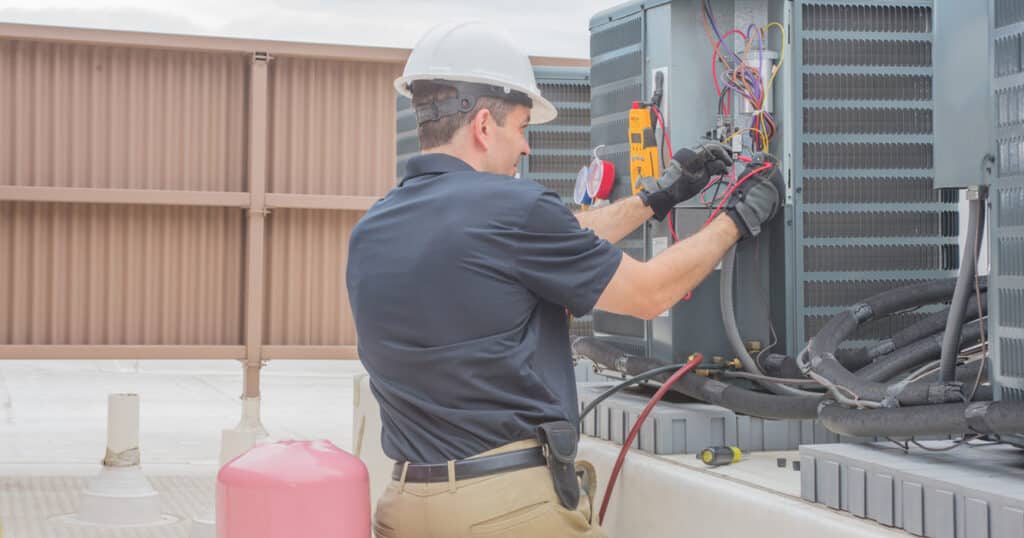How to Write a Job Description for an HVAC Service Technician
No HVAC company can be successful without skilled service techs. Before you can hire the right candidate, you’ll need a solid job description. Here’s how to write one, step by step.

Content Director
As an HVAC business owner, you know the importance of having qualified and capable service technicians on your team.
First, they play a vital role in keeping your customers’ homes and businesses comfortable. But they also help support the longevity of your company and scaling your HVAC business. After all, many of your customers will judge your entire business based on their interactions with your service technicians.
Not only that, but HVAC jobs are on the rise.
HVAC technician jobs are predicted to rise more than 5% by 2030. This growth highlights the need for HVAC service companies to hire and retain the best talent. See other HVAC Industry Statistics.
The first step to setting your HVAC business apart and attracting top talent is a clear, well-written HVAC service technician job description. It needs to be easy to read, engaging, chock-full of information, and accurate. It should include details on duties, qualifications, and skills required for the job.
In this article, we’ll cover everything you need to know about writing an HVAC service technician job description. When you’re done reading, you’ll be ready to write your own job description.
What Is a Job Description?
A job description is an overview of all the core information about a specific position.
It should convey a realistic picture of the duties and responsibilities of the job. The goal is to give candidates a clear idea of what their day-to-day will be like if you hire them.
The best job descriptions will also include additional information, like an overview of your company, work hours, and possibly even wages.
What to Include in a Job Description
Finding the right fit for your HVAC team can be difficult. It’s important to hire someone with the right qualifications, for sure. But you should also look for someone with a personality that meshes well with the rest of your team.
You want to attract the best possible candidates. Here’s a list of everything your job description should include to do just that.
Job Title
The first thing you’ll need to do is come up with a job title that accurately reflects the role you’re looking to fill.
Job titles for HVAC professionals can vary. Some job titles include seniority, experience level, or specific areas of responsibility into account. Some are even company-specific.
For example, your open position might use one of these sample job titles:
- Rough-In Installer
- Start-Up Technician
- Service Technician
- Service Manager
- Systems Engineer
There’s only one thing about the title that really matters. It needs to accurately reflect the job.
Job Purpose
The next thing you’ll need to include in your job description is the purpose of the role.
What will the HVAC service technician be responsible for? What tasks will they be expected to perform? Be sure to list both primary and secondary responsibilities.
Primary responsibilities will likely include things like maintaining, repairing, and installing residential and commercial HVAC systems.
Secondary responsibilities might include troubleshooting system issues, consultation, or even customer service.

Typical Duties and Responsibilities
After you’ve listed the primary and secondary responsibilities of the role, you’ll want to provide a more detailed list of typical duties. This is where you can get into the nitty-gritty of what the HVAC service technician will do daily.
Be sure to include both technical and non-technical duties, such as:
- Installing new HVAC systems according to manufacturer specifications
- Repairing and troubleshooting existing HVAC systems
- Performing preventative maintenance on HVAC systems
- Reading and interpreting blueprints and wiring diagrams
- Using hand tools, power tools, and testing equipment
- Providing excellent customer service
Required Qualifications and Licenses
Use this section to include any specific experience or licenses required for the job.
Be clear about the required certifications, qualifications, experience, and licenses. While there may be some advanced experience you’d like to see, this section should focus on the minimum requirements.
These can include:
- Certification or associate’s degree from an HVAC program at a technical school
- Required state licensing for HVAC technicians and contractors
- A valid driver’s license
Keep in mind, too, that your state may have additional requirements for HVAC technician certifications.
Preferred Qualifications
This section can be used to include any additional qualifications or certifications that aren’t essential but would be nice. These aren’t mandatory, but they can help you narrow down your pool of candidates.
For example, you might include:
- Experience working with a particular HVAC system
- Bilingualism
- Certification from a nationally recognized trade organization, such as the Air Conditioning Contractors of America (ACCA)
- Section 608 Technician Certification from the U.S. Environmental Protection Agency (EPA)
General Working Conditions
Use this section to provide information about the physical demands of the job, work hours, and travel requirements.
For example:
- Required to lift heavy objects, climb ladders, and work in tight spaces
- Typically hours are Monday-Friday, with occasional evening and weekend hours
- Required to travel to job sites
Compensation
This section is optional unless required in your state.
Whether it’s required or not, many job seekers appreciate knowing the pay range before applying for a job. If you do choose to include wage information, be sure to list the range rather than a specific amount.
The median pay for HVAC mechanics and installers in the U.S. is about $50,000 per year.
We recommend that you spend some time researching the average pay rates in your area before deciding on compensation.
You should also include any benefits in this section, like insurance, retirement plans, or other non-wage perks.

Preparing to Hire an HVAC Technician
Now that we’ve covered what goes into an HVAC service technician job description, you can create one that fits your company.
Be clear, honest, and detailed in describing who and what you’re looking for. Take the time to determine what’s important to you.
The person you hire will be a part of your team. They will absolutely impact your company.
When you’re ready to actually sit down and write your job description, here are some specific ways to get started:
- Outline the job title and purpose. List all the details that come to mind. It’s a critical first step to actually write down what the new role will entail. Why are you hiring this person? What will they be expected to do? What skills and experience are necessary for success?
- Calculate a pay range that fits within your budget. Evaluate average compensation in your area. There are several ways to do this. One easy option is to use Salary.com, a free database of salary information that will display results right down to the city you’re in.
- Talk to your current staff. Ask them what they feel are the most critical skills and qualifications for success with your customers. Also, ask them what they hope for in a new team member. Finding the right hire includes finding someone who blends in with your current team.
- Post your position online. Once you’ve crafted a job description and determined a budget, the final step is to post the job. There are several sites you could post your position on. One excellent option is Indeed.
Ashley’s professional experience includes content creation of all kinds, from articles and infographics to websites and whitepapers. When she’s not working, she enjoys dark coffee, dad jokes, and fiction—mostly horror and urban fantasy.

Business Solutions For Field Service Pros
EverPro offers specialized solutions designed for home and field service professionals. We’ve got the business tools to help you get the job done.



